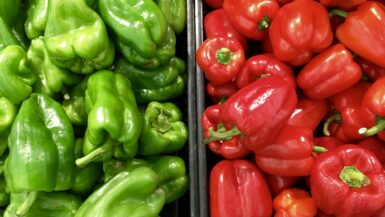Eating a diet rich in fruits and vegetables is essential for maintaining good health. They are packed with vitamins, minerals, fiber, and antioxidants that help protect your body against diseases and promote overall well-being. However, despite the numerous benefits, many people struggle to incorporate enough fruits and vegetables into their diets. In this article, we will explore some simple and effective ways to increase your intake of these nutritious foods and make healthy eating a part of your daily routine.
The Benefits of Eating More Fruits and Vegetables
Incorporating more fruits and vegetables into your diet is a simple and effective way to improve your overall health and well-being. Fruits and vegetables are packed with essential vitamins, minerals, and fiber that can help you maintain a healthy weight, reduce your risk of chronic diseases, and boost your immune system.
One of the main benefits of eating more fruits and vegetables is that they are low in calories and high in nutrients. This means that you can eat a larger volume of fruits and vegetables without consuming too many calories, which can help you maintain a healthy weight. Additionally, the fiber found in fruits and vegetables can help you feel fuller for longer, reducing your overall calorie intake.
Eating a diet rich in fruits and vegetables has also been linked to a lower risk of chronic diseases such as heart disease, stroke, and certain types of cancer. This is because fruits and vegetables contain antioxidants and other compounds that can help protect your body against damage from free radicals and inflammation.
Finally, incorporating more fruits and vegetables into your diet can help boost your immune system. Fruits and vegetables are rich in vitamins and minerals such as vitamin C, vitamin A, and zinc, which are essential for maintaining a healthy immune system. Eating a variety of fruits and vegetables can also help ensure that you get all the nutrients your body needs to function properly.
Overall, there are numerous benefits to eating more fruits and vegetables, and incorporating them into your diet is a simple and effective way to improve your health and well-being.
How to Set Realistic Goals for Incorporating More Fruits and Vegetables into Your Diet
Incorporating more fruits and vegetables into your diet can seem overwhelming, but setting realistic goals can help make the process easier and more manageable. Here are some tips for setting achievable goals:
Start Small
Rather than trying to completely overhaul your diet overnight, start by setting small goals for yourself. For example, aim to eat one serving of fruits or vegetables with each meal, or try adding an extra serving of fruits or vegetables to your daily snacks.
Be Specific
When setting goals, be specific about what you want to achieve. Rather than simply saying “I want to eat more fruits and vegetables,” set a specific goal such as “I want to eat at least 3 servings of vegetables per day.”
Make a Plan
Planning ahead can help you stick to your goals. Set aside time each week to plan your meals and snacks, and make a grocery list that includes plenty of fruits and vegetables.
Track Your Progress
Tracking your progress can help you stay motivated and see how far you’ve come. Keep a food diary or use a tracking app to monitor your fruit and vegetable intake and celebrate your successes.
Be Flexible
Remember that it’s okay to be flexible with your goals. Life can be unpredictable, and it’s important to be able to adjust your goals as needed. If you fall off track, don’t beat yourself up – simply recommit to your goals and keep moving forward.
Incorporating more fruits and vegetables into your diet doesn’t have to be difficult. By setting realistic goals and taking small steps, you can make lasting changes to your diet that will improve your health and well-being.
Tips for Meal Planning and Prepping with Fruits and Vegetables
Meal planning and prepping can help make it easier to incorporate more fruits and vegetables into your diet. Here are some tips to help you get started:
Plan Your Meals Around Fruits and Vegetables
When planning your meals, make sure to include plenty of fruits and vegetables. Aim to fill at least half of your plate with fruits and vegetables at each meal.
Choose a Variety of Colors
Eating a variety of fruits and vegetables can help ensure that you get all the nutrients your body needs. Aim to include a variety of colors in your meals, such as dark leafy greens, red and orange peppers, purple eggplants, and yellow squash.
Prep Your Fruits and Vegetables in Advance
Prepping your fruits and vegetables in advance can help save time during the week. Wash and chop your fruits and vegetables as soon as you bring them home from the grocery store, and store them in containers in the fridge for easy access.
Try Different Cooking Methods
Experiment with different cooking methods to find new ways to enjoy your fruits and vegetables. Roasting, grilling, and sautéing can all bring out different flavors and textures.
Use Fruits and Vegetables as Snacks
Fruits and vegetables can make great snacks throughout the day. Pack sliced veggies with hummus or salsa for a midday snack or grab an apple or banana on your way out the door.
Get Creative with Your Recipes
Don’t be afraid to get creative with your recipes. Add veggies to your omelets or smoothies, or use pureed vegetables as a sauce for pasta dishes.
By incorporating more fruits and vegetables into your meal planning and prepping, you can make it easier to eat healthy and improve your overall health and well-being.
Creative Ways to Add Fruits and Vegetables to Your Meals and Snacks
Adding more fruits and vegetables to your diet doesn’t have to be boring or bland. Here are some creative ways to incorporate more fruits and vegetables into your meals and snacks:
Blend Them Into Smoothies
Smoothies are a great way to pack in a variety of fruits and vegetables. Try blending spinach, kale, or avocado into your smoothies for a boost of nutrients.
Add Them to Your Oatmeal
Adding fruits such as bananas, berries or sliced apples to your morning oatmeal can make it more flavorful and nutritious.
Make Veggie-Based Dips
Instead of reaching for high-calorie dips like ranch or sour cream, try making your own dips with vegetables like roasted red peppers, eggplant or avocado.
Stuff Them Into Sandwiches and Wraps
Adding vegetables like lettuce, tomato, cucumber, and bell peppers to your sandwiches and wraps can add flavor, texture, and nutrients.
Make Veggie Noodles
Replace traditional pasta with zucchini or sweet potato noodles for a lower calorie, nutrient-packed alternative.
Top Your Pizza with Veggies
Add vegetables like spinach, mushrooms, or bell peppers to your pizza toppings for a flavorful and nutritious meal.
Use Fruits as Sweeteners
Instead of using sugar or artificial sweeteners, try using fruits like bananas, dates, or applesauce to sweeten your baked goods.
Incorporating more fruits and vegetables into your diet can be fun and delicious. By getting creative with your meals and snacks, you can make healthy eating enjoyable and sustainable.
How to Make Healthy Swaps with Fruits and Vegetables in Your Favorite Recipes
Swapping out less healthy ingredients with fruits and vegetables in your favorite recipes is a simple and effective way to incorporate more of them into your diet. Here are some tips for making healthy swaps:
Replace Pasta with Zucchini Noodles
Replace traditional pasta with zucchini noodles for a lower calorie, nutrient-packed alternative. You can use a spiralizer or a vegetable peeler to make the noodles.
Use Cauliflower Rice Instead of White Rice
Cauliflower rice is a great low-carb alternative to white rice. Simply pulse cauliflower in a food processor until it reaches a rice-like consistency and use it in your favorite rice dishes.
Add Veggies to Your Sauces and Soups
Add pureed vegetables like carrots, sweet potatoes, or butternut squash to your sauces and soups for added nutrients and flavor.
Use Avocado Instead of Mayo or Sour Cream
Avocado is a great substitute for less healthy ingredients like mayo or sour cream. Use mashed avocado in place of these ingredients in your dips, dressings or sandwiches.
Make Sweet Treats with Fruits
Replace sugar with fruits like bananas, dates, or applesauce in your baked goods. This will add natural sweetness and nutrients to your desserts.
Use Lettuce Wraps Instead of Tortillas
Lettuce wraps are a great alternative to tortillas or bread. Use large lettuce leaves to wrap your favorite sandwich fillings or taco ingredients.
By making healthy swaps with fruits and vegetables in your favorite recipes, you can make your meals more nutritious and flavorful. Start by making small changes and experiment with different ingredients to find what works best for you.
The Importance of Variety and How to Try New Fruits and Vegetables
Eating a variety of fruits and vegetables is important to ensure that you get all the nutrients your body needs. Here are some tips for trying new fruits and vegetables and incorporating variety into your diet:
Experiment with Different Colors and Textures
Try to eat a variety of different colored fruits and vegetables, such as green leafy vegetables, orange carrots or red tomatoes. Also, experiment with different textures, such as crisp apples, juicy berries or crunchy snap peas.
Shop at Your Local Farmers Market
Shopping at your local farmers market can expose you to a wider variety of fruits and vegetables. Talk to the farmers and ask for recommendations on how to prepare new or unfamiliar produce.
Try New Recipes
Trying new recipes is a great way to incorporate new fruits and vegetables into your diet. Look for recipes online or in cookbooks that feature ingredients you haven’t tried before.
Join a CSA or Delivery Service
Community Supported Agriculture (CSA) and delivery services can provide you with a variety of fruits and vegetables on a regular basis. This can encourage you to try new produce and incorporate more variety into your meals.
Eat Seasonally
Eating seasonally can help you try new fruits and vegetables and incorporate variety into your diet. Look for produce that is in season and experiment with new recipes.
By trying new fruits and vegetables and incorporating variety into your diet, you can ensure that you get all the nutrients your body needs. Start by making small changes and experiment with different ingredients to find what works best for you.
How to shop for and store fruits and vegetables to make them last longer
When it comes to incorporating more fruits and vegetables into your diet, it’s important to know how to shop for and store them properly to prevent waste and ensure they last longer. Here are some tips:
Shop for ripe produce
When shopping for fruits and vegetables, choose ripe produce that is ready to eat within a few days. This will ensure that you can consume them before they spoil. However, if you’re planning to use them later in the week, look for produce that is not yet ripe and will ripen over time.
Store produce correctly
Proper storage is key to making your produce last as long as possible. Some fruits and vegetables should be stored in the refrigerator, while others should be kept at room temperature. Here are some general guidelines:
- Refrigerate: Berries, grapes, cherries, leafy greens, broccoli, cauliflower, carrots, celery, peppers, and most other fruits and vegetables.
- Store at room temperature: Bananas, avocados, tomatoes, onions, garlic, potatoes, sweet potatoes, and winter squash.
Use proper storage containers
Proper storage containers can also help your produce last longer. For example, use a perforated plastic bag to store leafy greens and broccoli in the refrigerator. This will help prevent moisture buildup and keep them fresh for longer. Use a paper bag to store mushrooms, which will help them stay dry and prevent them from getting slimy.
Plan meals around produce
Another way to prevent waste is to plan meals around the produce you have on hand. This will ensure that you use up your produce before it goes bad. Look for recipes that use the fruits and vegetables you have, and plan meals accordingly.
By following these tips, you can shop for and store fruits and vegetables to make them last longer and prevent waste. This will help you incorporate more of these nutritious foods into your diet, without breaking the bank.
How to involve your family and friends in eating more fruits and vegetables
Eating more fruits and vegetables is not only beneficial for your health, but it can also be a fun and enjoyable experience for your family and friends. Here are some tips on how to involve them in eating more fruits and vegetables:
Make it a group effort
Involve your family and friends in the process of selecting and preparing fruits and vegetables. Take them with you to the farmer’s market or grocery store and let them pick out their favorite fruits and vegetables. Encourage them to help with meal preparation and cooking, and make it a fun and social activity.
Try new recipes together
Experiment with new recipes that incorporate fruits and vegetables. Look for recipes that are easy to make and have familiar ingredients. Encourage your family and friends to try new foods and flavors, and make it a group effort to find recipes that everyone enjoys.
Get creative with presentation
Make fruits and vegetables more appealing by getting creative with their presentation. Cut them into fun shapes or arrange them into colorful patterns. Use dips or sauces to make them more flavorful and enjoyable to eat.
Make it a game
Make eating fruits and vegetables a game by setting goals and tracking progress. Create a chart or scoreboard to keep track of how many servings of fruits and vegetables each person eats each day. Offer rewards or incentives for meeting daily or weekly goals.
Lead by example
The best way to encourage your family and friends to eat more fruits and vegetables is to lead by example. Make sure you are eating a variety of fruits and vegetables yourself, and talk about the benefits you are experiencing. Share your favorite recipes and encourage them to try new things.
By involving your family and friends in the process of eating more fruits and vegetables, you can make it a fun and enjoyable experience for everyone. With a little creativity and effort, you can encourage those around you to adopt a healthier and more nutritious diet.
How to overcome common barriers to eating more fruits and vegetables
Despite the many benefits of eating more fruits and vegetables, there are some common barriers that can make it difficult to incorporate them into your diet. Here are some tips on how to overcome these barriers:
Time constraints
One of the biggest barriers to eating more fruits and vegetables is lack of time. To overcome this, try prepping your fruits and vegetables ahead of time. Wash and chop them and store them in the refrigerator for easy access. You can also try buying pre-cut fruits and vegetables or using frozen fruits and vegetables, which are just as nutritious and require no prep time.
Budget constraints
Another barrier to eating more fruits and vegetables is the cost. To overcome this, try buying in-season produce, which is often cheaper and more readily available. You can also look for sales and discounts at your local grocery store, or try buying in bulk and freezing excess produce for later use.
Lack of variety
Eating the same fruits and vegetables every day can get boring. To overcome this, try experimenting with new fruits and vegetables. Visit your local farmer’s market or grocery store and try something new each week. You can also try incorporating fruits and vegetables into your meals in different ways, such as adding them to smoothies or salads.
Lack of knowledge or skills
Some people may be hesitant to try new fruits and vegetables because they are unfamiliar with them or don’t know how to prepare them. To overcome this, do some research on different fruits and vegetables and how to prepare them. Look for recipes online or in cookbooks, or ask a friend or family member for advice.
Lack of motivation
Finally, lack of motivation can be a barrier to eating more fruits and vegetables. To overcome this, remind yourself of the many benefits of eating a nutritious diet, such as improved energy levels and overall health. Set realistic goals for yourself and track your progress to stay motivated.
By overcoming these common barriers, you can incorporate more fruits and vegetables into your diet and reap the many benefits they offer. With a little effort and creativity, you can make healthy eating a part of your daily routine.





Leave a reply